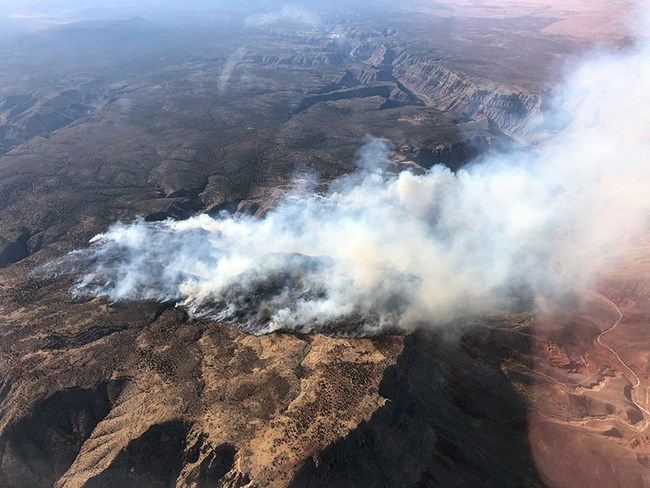Last updated: December 17, 2021
Article
Andrus Canyon Fire – Suppression Success at Grand Canyon-Parashant National Monument

NPS/G WOODALL
In late June 2021, the lightning-ignited Andrus Canyon Fire was discovered burning in a pinyon-juniper dominated woodland with little to no understory on the eastern side of Grand Canyon-Parashant National Monument. In the area of this woodland, pockets of light grass and sagebrush are common, with plateaus and canyons as far as the eye can see. Vegetation was experiencing exceptional drought and were highly receptive to fire spread, as winds, low humidity, and temperatures in the 90s helped the wildfire grow rapidly.
In the first 48 hours through full suppression, the Andrus Canyon Fire’s progress was slowed. Within the next 24 hours, the fire’s progression had been stopped. The Andrus Canyon Fire was limited to less than 1,700 acres, all entirely on National Park Service (NPS) land. So why was the response so successful, so quickly, and in such a remote area?

NPS/G WOODALL
By having previous fuel treatments and managed wildfires in this area, local NPS staff had great knowledge of the fire history, current and forecasted fire behavior, and logistical challenges faced. This allowed them to manage this incident at a lower complexity and with less personnel, especially as the whole country was starting to see requests for more and more resources as preparedness levels began to escalate nationally.
Previous relationships with the Bureau of Land Management (BLM), Color County Interagency Fire Center, and other partners allowed NPS fire leadership to quickly mobilize personnel and crews, such as the Snake River Interagency Hotshot Crew (BLM), which was already in the area.

NPS
Concurrently, internal relationships in the national monument allowed for the rapid intelligence sharing of cultural asset protection information. Cultural surveys had been conducted for the entire area, so NPS fire management staff knew where to avoid and when different tactics would be necessary. Having a local fireline-qualified resource advisor (REAF) from the NPS who previously worked on the fuels projects was key to quickly getting information and concerns to firefighters and fire personnel on the ground.
Lastly, local leadership at all levels was also key to the rapid-fire suppression success. Having a superintendent with strong fire experience aided in getting various requests such as a helispot analyzed and approved quickly. Additionally, having a Grand Canyon-Parashant Fire Management Plan assisted in quick decision-making, such as the use of fire retardant on the western and northern flanks, backed-up with crews on the ground, which in the end stopped the fire.
